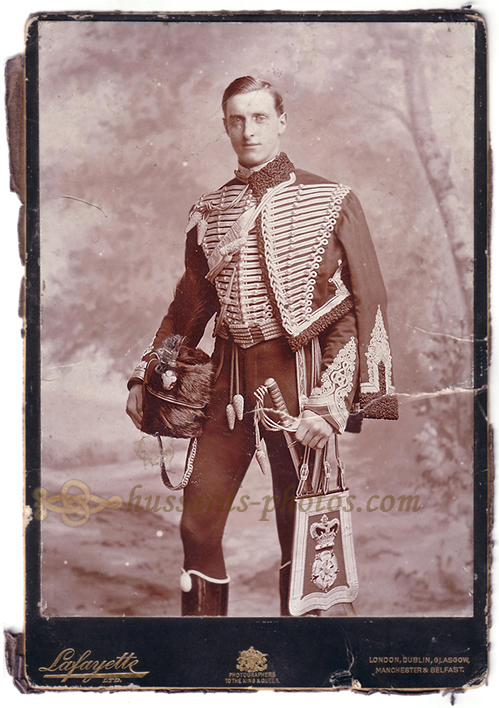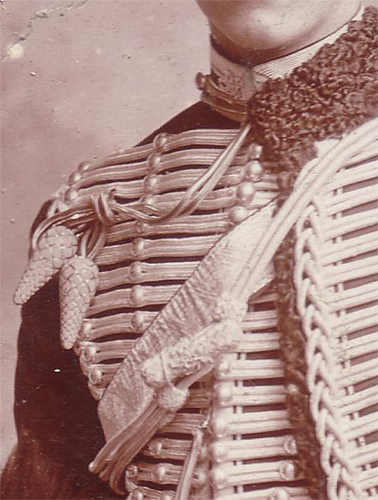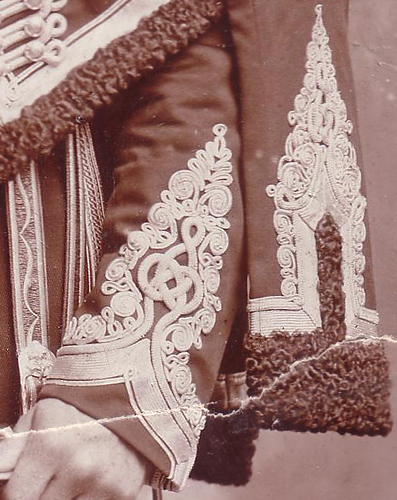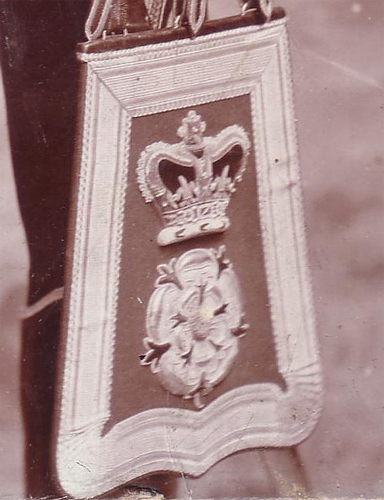Henry Bernard de la Poer Beresford-Peirse
was born on 9 January 9th, 1875, the eldest son of Sir Henry
Monson de la Poer Beresford-Peirse, 3rd Baronet, and Lady Adelaide
Mary Lucy Bernard, daughter of the 3rd Earl of Brandon.
He was educated at Eton, and graduated from Magdalen College,
Oxford in 1899 with a B.A.
He joined the Yorkshire Hussars (Princess
of Wales's Own) as a Supernumerary Second Lieutenant on September
26th, 1894.
He was interestingly gazetted into the regular Cavalry by the end
of 1899 :
"The undermentioned Officers to be Second
Lieutenants. Dated 20th December, 1899 :-
12th Lancers, Lieutenant Henry Bernard de la Poer Beresford-Peirse,
from Yorkshire Hussarss Yeomanry Cavalry, on augmentation."
A mere few days later, the Imperial
Yeomanry was born, through a Royal Warrant dated December 24th
1899. The standing Yeomanry Regiments were asked to provide
companies, and there was definitely a considerable success in
Yorkshire :
The Times, Wednesday, January 3rd, 1900.
"YORKSHIRE.- The enrolment of names at the Leeds School of
Arms again proceeded yesterday. The Yorkshire Hussars and the
Yorkshire Dragoons compose the 13th Yeomanry Brigade ; from the
Hussars there are 150 accepted applications and from the Dragoons
about 180."
The Times, Monday,
January 8th, 1900.
"YORKSHIRE.- The mobilization of the Yorkshire contingent of
the Imperial Yeomanry began on Saturday at the Sheffield Cavalry
Barracks. The contingent comprises the Yorkshire Dragoons and the
Yorkshire Hussars, the two regiments forming the13th Brigade. The
Leeds section of the Hussars mustered in the city square, Leeds,
where thousands of citizens had gathered to give them a patriotic
"send off." Captain Gervaise Beckett, who is hon.
treasurer of the equipment fund, also accompanied the men to the
Middland Station where there was a scene of great enthusiasm on
the departure of the train. There were similar demonstrations in
other centres. Civilians are to muster at Sheffield to-day, and it
is expected that by to-morrow fully 300 men will be under training
for the Yorkshire contingent to be made up subsequently, if
possible, to about 1,000, composed of eight or ten companies.
Captain W.G.Eley, formerly of the 14th Hussars, is adjutant of the
brigade squadron. For garrison duty and to assist the adjutant,
Captain Harcourt Wood and Lieutenants Beresford-Peirse and
S.Wombell have been assigned. Colonel the Earl of Scarborough, who
has been ill with influenza, has made it a sine qua non that
members of the contingent should be thoroughly efficient as ridres,
and it is probable that the number of those who have been
disqualified for medical and other reasons will be yet increased.
The equipment and emergency fund of the contingent now approaches
£10,000, the latest contributors including Lord St.Oswall, the
Earl and Countess of Yarborough, Sir R.T.Tempest, Viscountess
Downe, Mr.E.C.Thompson, Messrs.T.F.Firth and Son, Mr.H.H.Riley,
the Earl of Scarborough, and Mr.W.J.Richardson,, £100 each."
The slightly odd situation of Lieutenant Beresford-Peirse (remember
he just joined the 12th Lancers!) would
soon be fixed through the London Gazette :
"War Office, Pall-Mall, January 16th.
12th Lancers.- The appointment to a Sec.Lieutenancy of Lieut. H.B.
de la P. Beresford--Peirse, from the Yorkshire Hussars
Yeomanry Cavalry, which appeared in the Gazette of Dec.19, 1899,
is cancelled."
And it was high time, as the next day :
The Times, Wednesday, January 17th, 1900
"YORKSHIRE.- The first Yorkshire detachment
of the Imperial Yeomanry has now been completed. It consists of
two companies of 240 men of all ranks, who are now stationed at
Sheffield Barracks. The task ofmaking the final selection was a
difficult one in consequence of the number of volunteers.
Yorkshire, however, is not to be represented by one detachment
only, and when the two companies now training quit the barracks
the men whose offers in the first instance have had to be refused
will be called upon to form a second detachment. The following
officers have been recommended to the War Office for service with
the two companies : -Yorkshire Dragoons.-Captain Crichton-Browne,
Captain Simpson, Lieutenant Smith, Lieutenant Jeffcock, and
Lieutenant Doxat. Yorkshire Hussars.- Major Gascoigne, Lieutenant
Wombell, Lieutenant Beresford-Peirse, Lieutenant Wilson, and
Lieutenant Mackillop. Captain Crichton-Browne is an officer of the
Militia battalion of the King's Own Scottish Borderers, and has
served for three years in South Africa in the Rhodesia Horse.
Major Gascoigne served in the Nile expedition, 1884-85, as an
officer in the Royal Horse Guards".
You will have noted that the Yorkshire detachment was (a bit
prematurely !) announced as "forming the 13th Brigade"
; the Imperial Yeomanry was eventually rather organized in
Battalions, the Yorkshire Hussars forming the No.9 Company
of the 3rd Battalion.
The departure for South Africa would not wait for long, and on
Sunday, January 29th, in Liverpool (Langton Dock), "Companies
No.9, 10, 11 and 12, a total of 578 men , with 457 horses, arrived
at the Alexandra Dock Station, Liverpool, and embarked on
board the Winefredian (transport 78), of the Leyland Line. No.9
Company, the Yorkshire Hussars, numbered 122 rank and file, under
Captain Trench Gascoyne, and Lieutenants McKillop, Beresford-Peirse
and Wilson."
Lieutenant Bereford-Peirse's status would again change soon :
"War office, Pall-Mall, February 2, 1900.
THE IMPERIAL YEOMANRY
To be Adjutants.-(...) Lieut. H.B. de la P. Beresford-Peirse,
Yorkshire Hussars, with the temporary rank of Captain in the Army."
Some more official paperwork was to come along - one really
gets the feel that the whole Imperial Yeomanry scheme was a kind
of administrative nightmare to the War Office clerks :
"War office, Pall-Mall, February 9,
1900.
MEMORANDUM
The undermentioned Officers are seconded for service with the
Imperial Yeomanry :-
Yorkshire Hussars (Princess of Wales's Own). Lieut. H.B. de la P.
Beresford-Peirse."
The Yorkshire Hussars (or rather, No.9 Company) landed in South
Africa on the 20th February.
They were one of the lucky Companies to have come along with a
full complement of their own horses - remount was to be
problematic for other units.
The Yeomanry Companies were directed on arrival in Cape Town to
the nearby Imperial Yeomanry camp at Maitland, where they
completed their training and waited for the other Companies to
reach South Africa.
The 3rd battalion was under the orders of Lieutenant-Colonel
G.I.Younghusband. They were part of the contingent sent in March to
Mafeking, attached to Lord Methuen's Column. They engaged the
enemy at Boshof in April :
"from The Great Boer War, by Sir Arthur Conan Doyle.
"In this short period of depression there
came one gleam of light from the west. This was the capture of a
commando of sixty Boers, or rather of sixty foreigners fighting
for the Boers, and the death of the gallant Frenchman, De
Villebois-Mareuil, who appears to have had the ambition of playing
Lafayette in South Africa to Kruger's Washington. From the time
that Kimberley had been reoccupied the British had been
accumulating their force there so as to make a strong movement
which should coincide with that of Roberts from Bloemfontein.
Hunter's Division from Natal was being moved round to Kimberley,
and Methuen already commanded a considerable body of troops, which
included a number of the newly arrived Imperial Yeomanry. With
these Methuen pacified the surrounding country, and extended his
outposts to Barkly West on the one side, to Boshof on the other,
and to Warrenton upon the Vaal River in the centre. On April 4th
news reached Boshof that a Boer commando had been seen some ten
miles to the east of the town, and a force, consisting of
Yeomanry, Kimberley Light Horse, and half of Butcher's veteran 4th
battery, was sent to attack them. They were found to have taken up
their position upon a kopje which, contrary to all Boer custom,
had no other kopjes to support it. French generalship was
certainly not so astute as Boer cunning. The kopje was instantly
surrounded, and the small force upon the summit being without
artillery in the face of our guns found itself in exactly the same
position which our men had been in twenty-four hours before at
Reddersberg. Again was shown the advantage which the mounted
rifleman has over the cavalry, for the Yeomanry and Light Horsemen
left their horses and ascended the hill with the bayonet. In three
hours all was over and the Boers had laid down their arms.
Villebois was shot with seven of his companions, and there were
nearly sixty prisoners. It speaks well for the skirmishing of the
Yeomanry and the way in which they were handled by Lord Chesham
that though they worked their way up the hill under fire they only
lost four killed and a few wounded. The affair was a small one,
but it was complete, and it came at a time when a success was very
welcome. One bustling week had seen the expensive victory of Karee,
the disasters of Sanna's Post and Reddersberg, and the successful
skirmish of Boshof. Another chapter must be devoted to the
movement towards the south of the Boer forces and the dispositions
which Lord Roberts made to meet it."
The events would not always turn out so favourably, and the
Morning leader would publish, on June 4, 1900 :
"Poor Yorkshire Hussars.
Writing home from the Convalescent Home,
School of Mines, Kimberley, Private Jesse Helliwell, of the
Imperial Yeomanry, says : « The poor Yorkshire Hussars are
now not more than half theirstrength, there are s many sick and
wounded and a lot of prisoners. I was lying in the ambulance
during the engagement at Swarzkopjefontein, but I couldsee them
peppering away. The Boers fired a few shells at us, but they could
not get the range. It ias a terrible thing to see the dead and
dying,but you get used to it. I think the Yorkshire Hussars have
seen as much service as any, considering the time they have been
here. »"
Here is an overall account of the services of the Yorkshire Yeomanry
during the War (from "His Majesty's Territorial Army",
by Walter Richards) :
"Few, if any, Yeomanry contingents did more
brilliant work than did these Companies of Yorkshire Dragoons and
Hussars. They were the first of the Imperial Yeomanry to reach
South Africa ; and at Tweefontein, when that gallant soldier of
fortune, de Villebois Mareuil, met his death, they took part in
the first action in which the Yeomanry was engaged.They fought
under Methuen and Hunter, under Milne and Ridley and Clements,
Paget, Baden Powell, Hickman, and Plumer, Lord Erroll, Colonel
Doran, and Colonel Scobell. From the 24th March 1900 to the 4th
April 1901 the regiment was in action on thirty-nine occasions,
fifteen of which were general engagements. Total miles marched
3173. The 66th Company took part in thirteen general actions,
besides several minor engagements." The " new "
squadrons compiled a record of almost constant fighting and
wearisome "trekking ». It may well be wished that a
regimental history of the achievements of the Yorkshire Dragoons
and Hussars in South Africa might be published : it would be a
valuable and inspiriting contribution to the annals of the War. In
these pages it can only be attempted to mention— and that almost
at random—a few of the occurrences in which they most signally
distinguished themselves. At Rooidam in May we read in The Time’s
History of the War that « The Yorshire Dragoons, at a gallop,
seized a kraal from which a short advance enabled them to occupy a
kopje enfilading the main position ; we hear of the Yorkshire
Hussars distinguishing themselves themselves— and losing heavily—in
a rearguard action with Olliver ; we hear of constant and severe
fighting with the indomitable de Wet, of fierce conflicts at
Lilydale, Jacobsdal, Hartbeetsfontein, and Senekal. Perhaps –
for space forbids any approach to a detailed account—the most
brilliant feat of arms to be recorded of the Yorkshire Yeomanry
was that at Middlepost in February 1902, when " Lieutenants
Chichester and Tabor were sent up to hold a ridge with the men of
the Yorkshire Dragoons, their orders being that it was to be held
till death. And held it was – till death. Both officers and five
men were killed, and five men wounded. « They fought till
the last man was down, it never entering into the head of any of
these men to leave his post in any other way than on a stretcher.
Of the many fine things done by Yorkshiremen at the front none
should rank higher in the annals of the county than the way this
little band of men lay on that stony kopje and quietly fought it
out till there was none left to fight."
We can roughly follow Beresford-Peirse's steps in South-Africa
thanks to his being awarded the Queen's South Africa Medal
with four Clasps, "Cape Colony", "Orange Free
State", "Transvaal" and "South Africa
1901", these Clasps being the ones usually
observed on the Medals for No.9 Company.
They were awarded according to specific rules :
- Cape Colony : Awarded to troops serving in Cape Colony
between 11 October 1899 and 31 May 1902
- Orange Free State : Awarded to troops serving in
Orange River Colony any time from 28 February 1900 to 21 May 1902
- Transvaal : Awarded to those troops serving the
Transvaal at any time between 24 May 1900 and 31 May 1902, who
received no other clasp for action in the Transvaal
- South Africa 1901 : Awarded to those not eligible for
the King's Medal although they had served at the front between 01
January and 31 December 1901 (to be eligible for the King's Medal,
one had to serve in South Africa on or after 1st January 1902).
Beresford-Peirse was promoted to Temporary Major and
Second-in-Command on June 1st 1900.
The term of engagement of Officers and men of the Imperial
Yeomanry was for "one year, or not less than the period of
the war".
The first contingent of the Yorkshire Hussars made their way home
on board the Mongolian, leaving Cape Town on May 8th, 1901.
Major Beresford-Peirse was aboard, as well as "51 men of
9th Company" - to be compared with the 122 that had left
for South-Africa the previous year.
They only reached Southampton on June 8th, as reported in The
Times on June 10th :
"The arrival of the Mongolian, with the
first complete Yeomanry detachments from South Africa on board,
was the occasion for a great demonstration at Southampton on
Saturday afternoon. Visitors had been arriving from all parts of
the country for some days, and directly the news were received
that the vessel had been signalled at Hurst Castle hundreds made
their way to the docks.
The
Mongolian was delayed some time in Southampton Water ponding the
usual medical examination, and did not enter the dock until
shortly after 4 o'clock.By this time fully 1,000 people were
congregated on the quay, and, as the vessel came alongside,
enthusiastic cheers were raised on ship and shore, and hats and
handkerchiefs were waved. (...) The Mongolian left Cape Town on
May 8. When near the Equator a defect was discovered in the
transport's machinery, and the vessel had to be stopped pending
the necessary repairs, which were effected by two of the Yeomen on
board, and they were suitably rewarded for their services. All
this time the heat was intense,and many of the men were obliged to
sleep on deck. Among the returning officers was Captain John Seely,
M.P., who had the distinction of having been twice elected
toParliament during his absences in South Africa. There were seven
deaths during the voyage, those not previously reported being of
Cpl.Hodgkinson and Trooper Fletcher, of the Derbyshire Yeomanry,
both of Enteric. (...)"
There followed for Beresford-Peirse a few administrative
operations :
"London Gazette, July 5th 1901
MEMORANDUM.
The undermentioned Supernumerary Officers are borne as absorbed
into the Establishments of their respective units :-
IMPERIAL YEOMANRY.
Yorkshire Hussars (Princess of Wales's Own).-Lieut. H.B.de la
P.Beresford-Peirse."
"War Office, Pall-Mall, 9th July,
1901.
THE IMPERIAL YEOMANRY.
The undermentioned Officers relinquish their commissions. Dated
10th July, 1901 :-Temporary Maj. H.B.de la P.Beresford-Peirse,
second in Command."
Beresford-Peirse was mentioned in Earl Roberts's September 10th
Despatch.
He was awarded a D.S.O. on September 27th, at the recommendation
of Colonel Sir G.J. Younghusband :
"Henry Bernard de la Poer Beresford-Peirse, Major, 3rd
Battalion Imperial Yeomanry. In recognition of services
during the operations in South Africa".
It would appear that he was actually mentioned twice in despatches
during the War.
He was conferred his Order by King Edward VII at the Investiture
held at St.James's Palace on December 17th, 1901.
It was not over with administrative operations yet :
"War Office, Pall-Mall, Jan. 3 1902.
THE IMPERIAL YEOMANRY (IN SOUTH AFRICA)
The undermentioned Officers, on having relinquished their
commissions, are granted honorary rank in the Army as follows,
with permission towear the uniform of the Corps :-
3rd Battalion.-(...) To be Hon. Majors : (...) Maj.H.B.de la
Beresford-Peirse, D.S.O."
"War Office, March 4 1902.
MEMORANDUM
IMPERIAL YEOMANRY.
The undermentioned Officers resign their commissions and receive
new commissions subject to the provisions of the Militia and
Yeomanry Act, 1901, each retaining his present rank and seniority,
viz.:-
(...) Yorkshire Hussars (Princess of Wales's Own). (...)
Lieut.H.B.de la P.Beresford-Peirse, D.S.O."
A couple weeks later, on Friday, March 14th, he attended
"a service (...) held (...) at Manfield Church, near
Darlington, in memory of Colonel J.G.Wilson, C.B., of Cliffe-hall,
who was killed at Klip Drift. (...) The lych-gates at the entrance
to the churchyard were erected last June by public suscription in
memory of Colonel Wilson's son, who also died in South Africa".
The latter, Lieutenant Richard Bassett Wilson, had died at
Rustenburg on July 26th, 1900, of wounds received in action five
days previously at Oliphant’s Nek - he was an officer of the
Yorkshire Hussars.
It is to be noted that an unofficial tribute medal was awarded
by the "Committee of the Yorkshire Volunteer Equiptment
& Emergency Fund" to all members of the 3rd battalion
(Yorkshire) Imperial Yeomanry "in recognition of their
patriotism and the good service rendered by them in South Africa".
Beresford-Peirse would put his military career to an end the
following year :
"War Office, 23rd January, 1903.
IMPERIAL YEOMANRY.
Yorkshire Hussars (Princess of Wales's. Own), Lieutenant (Honorary
Major in the Army.) H. B. de la P. Beresford-Peirse, D.S.O.,
resigns his Commission. Dated 24th January, 1903."
Beresford-Peirse married on July 7th, 1904, Lady Mabel Marjorie
Campbell, second daughter of the 3rd Earl of Cawdor (1876-1966). They had two
sons, Henry Campbell (1905-1972) and Peter (1907-1984).
He became Clerk to the Wye fishery Board and Secretary to the Wye
Fisheries Association, 1903-12. He was appointed Under Treaseurer,
Middle Temple, 1912-30. He held the office of Justice of the Peace
(J.P.) for North Riding, Yorkshire.
He succeeded to the title of 4th Baronet Beresford, of Bagnall,
co. Waterford at the death of his father, on July 8th, 1926.
He died on May 14th, 1949.
Many thanks to Dave Knight, Stuart W. Elliott,
QSAMike and Terry "Greenfield"
|




